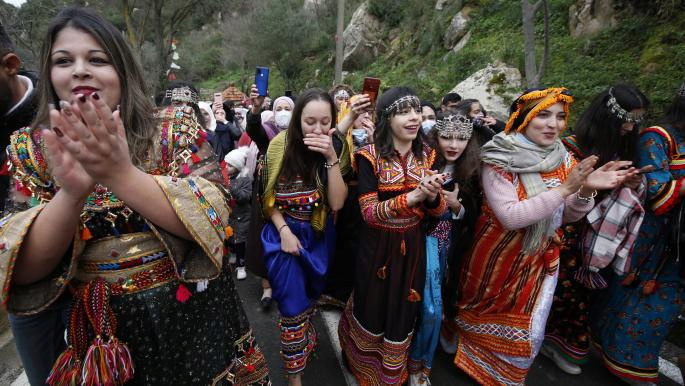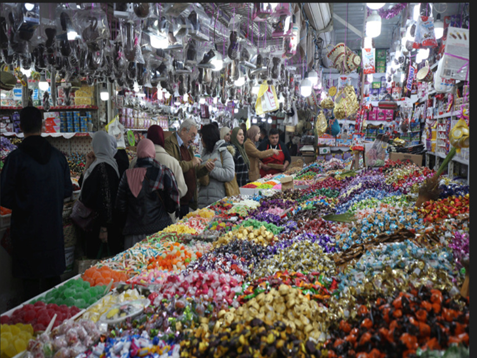"Eid Al-Nair"... The year of the Amazighs of Algeria begins to celebrate the land

"Eid Al-Nair" in the best way in Algeria
On the night of January 12 of each year, the Ghazran family, who live in the Batna region, which is located in the high mountains of the Aures in eastern Algeria , celebrates the advent of the Amazigh year and its meanings , which embody strong ties and great importance to the land , and constitute an occasion to launch a new year of plowing and scattering practices. Seeds in the ground and start waiting for the crops to grow, while making sure to welcome the New Year with the sweetest images of celebrations, and the most delicious dishes that are prepared from agricultural ingredients.
Kahina Ghazran, 35, tells Al-Araby Al-Jadeed that “Al-Nair” is a holiday for most Algerians, and our family celebrates it generation after generation, in tradition .Its members inherited it from father to grandfather. For us, it means working and waiting for good and abundant harvests. Some call the holiday "Ad-Al-Nair" or "Thaporth Osqas" or "Amenzo January", and these are Amazigh designations that mean the door of the Sunnah. Despite these different names, the celebration of the beginning of the Amazigh year has always been associated with the origin of human existence, which is the land. The "Eid Al-Nair" ritual
launches the agricultural year, where the Amazighs are optimistic about rain and snow so that blessings may prevail and the year will be fertile, and their wishes for a year of goodness and bountiful crops will increase.
The sanctification of the land
and the celebration symbolizes the hope for goodness and the blessing of the farming season. Ammar Swamy (42 years), who lives in the Sidi Aish area in the wilaya of Bejaia in the Lesser Kabylie region in central Algeria, told Al-Araby Al-Jadeed that the lingering image of the feast is in the minds of the inhabitants of the Amazigh regions of Algeria. It is the sanctification of the land and its cultivation. And every throne, tribe, or large family has its land, which includes vast areas of olive trees, wheat, prickly pear, vegetables, potatoes, beans, and grapes, which means that it is a source of their livelihood from production, consumption, sale, and trade. The sanctification of the land is an inherited matter between the grandparents, parents and grandchildren who preserve it. And they return to it even if they are alienated from it and leave it, and this is a natural matter, to plow, plant and exploit its fruits.”
"January dinner"
On this occasion, Algerian families choose many ways to express joy and happiness with the advent of these days, including customs that include preparing food to be cooked on this particular day, and its ingredients are often made from agricultural crops in order to prepare banquets for what is called in the Amazigh name "Amensi Ninar." or "January dinner". Families prepare delicious dishes of wheat flour, vegetables, grains, dry fruits, natural butter and honey at their tables.

In the Eid markets
Dishes
The "couscous" dish is often served on the night of the celebration of this occasion. According to what Fatima (62 years old) says, it is prepared with couscous grains that are steamed. Couscous broth is also prepared with various vegetables, beans and chickpeas, and the "porridge" dish that contains wheat flour with butter. And "Oftian", which is a soup of chickpeas, wheat, beans and other dry grains, which in turn is considered one of the signs of fertility and abundance of different agricultural crops. Some areas, such as Mila, Tamhamat, and Al Hamma, east of the Algerian capital, are also known for cooking "Cherchem" by boiling lentils, chickpeas, and wheat in water and salt, in preparation for distributing it to family and neighbors to spread goodness, in addition to cooking pancakes with honey to be optimistic about a happy year ahead.
Some families in the Amazigh regions of Cherchell, El-Tens, and Bani Hawa, west of the Algerian capital, slaughter turkeys in front of the doorsteps of houses, i.e. blood is shed in front of the entrances of houses, in a custom called “asfal” in the Berber language, and Fatima describes it as “among the rituals that many families still practice with Starting the Amazigh calendar with the aim of banishing evil and bringing good and various joyful wishes.
Thus, the occasion is considered an opportunity for the family and relatives to gather around the dinner banquet on the night of the celebration of "Al-Nair". Hakim Faratsa, who is interested in the Amazigh heritage, told Al-Araby Al-Jadeed: “In addition to the various dishes, most families prepare hot soup that includes seven types of grains, including wheat, corn, lentils and beans. They played the tambourine and sang January songs to welcome the coming of January.
The history of victory
The Amazighs depend for many decades on the agricultural calendar to cultivate, plant and water their lands, as it takes place through cooperation and social solidarity between families in villages and villages. They congratulate each other with the words "Isqas amgaz" or Happy New Year.
This occasion takes a historical dimension and context. Saida Saida, a specialist in popular culture from the University of Algiers, said in her interview with Al-Araby Al-Jadeed: “The beginning of the Amazigh year was dated on the day of the victory of the Amazigh or Amazigh king Shashnaq over King Ramses III of the Pharaohs’ family in Egypt, in the year 950 BC, during the battle of It was witnessed in the Beni Senus region, near the state of Tlemcen, in the far west of Algeria.From here, the celebration of the Amazigh year takes a deeper turn in the Beni Senus region in particular, and it is called the Irath festival or the Lion celebrations, and it includes a group of customs and rituals that last for days in the first month of the year, and the relationship is evident in it between man, earth and nature.
The festival is summarized in the wearing of two costumes made of leather and tree branches, representing the role of the pregnant lioness and the lion, as the lioness places her baby under the lion's eye, in a symbolic image of the beginning of a new life.
Also, in their celebrations, the Amazighs place green herbs on the roofs of houses, embodying a scene symbolizing nature, plants, and the rebirth of life. The celebrations also reflect the social dimension of customs by maximizing social solidarity between people, and providing food, food and meat to the poor and needy.
Source : websites

